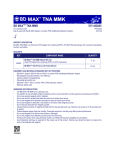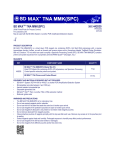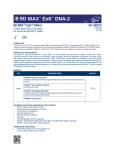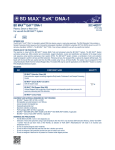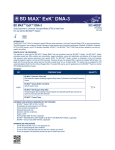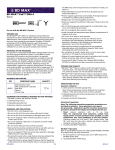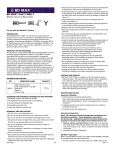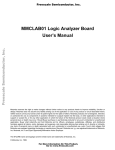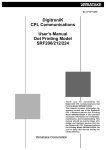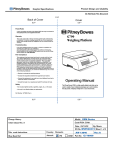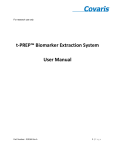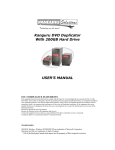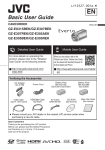Download BD MAX™ ExK™ TNA-2 442825 - BD Molecular Diagnostics
Transcript
BD MAX™ ExK™ TNA-2 442825 P0069(03) Cerebral spinal fluid For use with the BD MAX™ System 2015-02 INTENDED USE The BD MAX ExK TNA-2 is intended to extract total nucleic acid (TNA) from cerebral spinal fluid (CSF) specimens. The TNA Extraction Tube contains a Specimen Processing Control sequence from a proprietary Armored RNA® Quant™ (Asuragen, Inc.)*. The BD MAX ExK TNA-2 has not been validated for use with any specific test method. PRINCIPLES OF THE PROCEDURE The specimen is mixed with the BD MAX Sample Buffer Tube and processed using the BD MAX System. The BD MAX System automates sample lysis, TNA extraction and concentration, reagent rehydration, nucleic acid amplification and detection of the target nucleic acid sequence using real-time polymerase chain reaction (PCR). The BD MAX System contains a combination of lytic and extraction reagents designed to perform cell lysis and TNA extraction. Following cell lysis, the released nucleic acids are captured by magnetic affinity beads. The beads with the bound nucleic acids are washed and then the TNA is eluted using 12.5 µL of Elution Buffer. The solution may be prepared for PCR using Neutralization Buffer from the Unitized Reagent Strip. The eluted TNA may be used for applications on the BD MAX System or another PCR Amplification/Detection System. REAGENTS REF COMPONENT NAME QUANTITY BD MAX™ ExK™ TNA Extraction Tube (B4) Dried extraction reagent containing magnetic affinity beads, Proteinase K and Specimen Processing Control 442825 BD MAX™ ExK™ TNA-2 Sample Buffer Tube (with 25 septum caps) BD MAX™ TNA Reagent Strip (TNA) Unitized Reagent Strip containing all liquid reagents and disposable pipette tips necessary for specimen processing and TNA extraction BD MAX™ Conical Tubes P0069(03) 24 EQUIPMENT AND MATERIALS REQUIRED BUT NOT PROVIDED • BD MAX™ System: REF 441916 or 441927 • Micropipettes (accurate between 2 and 1000 µL) • Aerosol resistant micropipette tips • Disposable gloves/lab coat • Specimen collection container(s) • PCR Cartridges (REF 437519), if applicable • BD MAX™ TNA MMK (SPC) (REF 442830) or BD MAX™ TNA MMK (REF 442845), if applicable • BD MAX™ Conical Tubes (REF 437016), if applicable WARNINGS AND PRECAUTIONS • The BD MAX ExK TNA-2 is for in vitro diagnostic use. • Do not use expired reagents and/or materials. • Do not use the kit if the label that seals the outer box is broken upon arrival. • Do not use reagents if the protective pouches are open or broken upon arrival. • Do not use reagents if desiccant is not present or is broken inside reagent pouches. • Do not remove desiccant from reagent pouches. • Close protective pouches of reagents promptly with the zip seal after each use. Remove any excess air in the pouches prior to sealing. • Protect reagents against heat and humidity. Prolonged exposure to humidity may affect product performance. • Do not use reagents if the foil has been broken or damaged. • Do not mix reagents from different pouches and/or kits and/or lots. • Do not interchange or re-use caps, as contamination may occur and compromise test results. • Check Unitized Reagent Strips for proper liquid fills (ensure that the liquids are at the bottom of the tubes) (refer to Figure 1). • Check Unitized Reagent Strips to ensure that all pipette tips are present (refer to Figure 1). • Proceed with caution when using chemical solutions, as Extraction Tube barcode readability may be altered. • Good laboratory technique is essential to the proper performance of this assay. Due to the high analytical sensitivity of this test, extreme care should be taken to preserve the purity of all materials and reagents. • In cases where other PCR tests are conducted in the same general area of the laboratory, care must be taken to ensure that the BD MAX ExK TNA-2, any additional reagents required for testing, and the BD MAX System are not contaminated. Avoid microbial and ribonuclease (RNase)/deoxyribonuclease (DNase) contamination of reagents at all times. The use of sterile RNase/DNase-free disposable aerosol resistant or positive displacement pipette tips is recommended. Use a new tip for each specimen. Gloves must be changed before manipulating reagents and cartridges. • To avoid contamination of the environment by amplicons, do not break apart the BD MAX PCR Cartridge after use. The seals of the BD MAX PCR Cartridges are designed to prevent contamination. • The laboratory should routinely perform environmental monitoring to minimize the risk of cross-contamination. • Always handle specimens as if they are infectious and in accordance with safe laboratory procedures such as those described in CLSI Document M291 and in Biosafety in Microbiological and Biomedical Laboratories2. • Wear protective clothing and disposable gloves while handling all reagents. • Wash hands thoroughly after performing the test. • Do not pipette by mouth. • Do not smoke, drink, chew or eat in areas where specimens or kit reagents are being handled. • Dispose of unused reagents and waste in accordance with local, state, provincial and/or federal regulations. • Consult the BD MAX System User’s Manual3 for additional warnings, precautions and procedures. STORAGE AND STABILITY • BD MAX ExK TNA-2 components are stable at 2 - 25 °C through the stated expiration date. Do not use if expired. • The BD MAX TNA Extraction Tubes (B4) are provided in sealed pouches. To protect product from humidity, immediately re-seal after opening. The Extraction Tubes are stable for up to 14 days at 2 - 25 °C after initial opening and re-sealing of the pouch. Unreconstituted Extraction Tubes are stable for up to 4 hours at 2 - 25 °C after being removed from their protective pouch. 2 INSTRUCTIONS FOR USE Specimen Collection 1. Collect specimen and label appropriately. 2. Collected specimens should be maintained per the conditions validated by the user. 3. Proceed to Extraction Preparation. Extraction Preparation: Note: The following extraction preparation procedures are provided as guidance. Some specimens may require preprocessing. Application-specific extraction preparation procedures should be developed and validated by the user. 1. Pipette 200 µL of specimen into a BD MAX TNA-2 Sample Buffer Tube and close the tube with a septum cap. Ensure complete mixing by vortexing the sample. 2. Proceed to BD MAX System Operation. BD MAX System Operation Note: Refer to the BD MAX System User’s Manual3 for detailed instructions (Operation section). 1. Power on the BD MAX System (if not already done) and log in by entering <user name> and <password>. 2. Gloves must be changed before manipulating reagents and cartridges. 3. Remove the required number of Unitized Reagent Strips from the BD MAX ExK TNA-2 kit. Gently tap each strip onto a hard surface to ensure that all the liquids are at the bottom of the tubes. 4. Remove the required number of Extraction Tube(s) and Master Mix Tube(s) (if applicable) from their protective pouches. Remove excess air, and close pouches with the zip seal. 5. For each specimen to be tested, place one (1) Unitized Reagent Strip on the BD MAX System Rack, starting with Position 1 of Rack A. Assemble the strip as follows: Note: A tube is fully seated in the strip when a ‘click’ is heard. Refer to Figure 1 for reagent placement in the Unitized Reagent Strip. a) Extraction only: • Position 1 = Snap the TNA Extraction Tube into position 1. • Position 2 = Leave position 2 empty. • Position 3 = Snap a BD MAX Conical Tube into position 3. • Position 4 = Leave position 4 empty. b) Type 1: BD MMK or MMK(SPC) and Dried Primers and Probes: • Position 1 = Snap the TNA Extraction Tube into Position 1. • Position 2 = Snap the BD MAX TNA MMK (SPC) or BD MAX TNA MMK Master Mix Tube into position 2. • Position 3 = Snap a BD MAX Conical Tube containing dried-down primer and probe mixture (at a final concentration of 2X) into position 3. • Position 4 = Leave position 4 empty. c) Type 2: BD MMK or MMK(SPC) and Liquid Primers and Probes: • Position 1 = Snap the TNA Extraction Tube into Position 1. • Position 2 = Snap the BD MAX TNA MMK (SPC) or BD MAX TNA MMK Master Mix Tube into position 2; follow the instructions for use accompanying that product. • Position 3 = Snap a BD MAX Conical Tube into position 3. Pipette 12.5 µL of user supplied primer and probe mixture (at a final concentration of 2X) into the bottom of the Conical Tube in position 3. • Position 4 = Leave position 4 empty. d) Type 3: Liquid MM with Primers and Probes: • Position 1 = Snap the TNA Extraction Tube into Position 1. • Position 2 = Leave position 2 empty. • Position 3 = Snap a BD MAX Conical Tube into position 3. Pipette 12.5 µL of the user supplied master mix, primer and probe mixture (at a final concentration of 2X) into the BD MAX Conical Tube in position 3. • Position 4 = Leave position 4 empty. e) Type 4: Lyophilized MM with Primers and Probes: • Position 1 = Snap the TNA Extraction Tube into Position 1. • Position 2 = Snap a BD MAX Conical Tube containg user-supplied lyophilized master mix in position 2. 3 • • f) Position 3 = Snap a BD MAX Conical Tube into position 3. Pipette 12.5 µL of user-supplied rehydration buffer into the BD MAX Conical Tube in position 3. Position 4 = Leave position 4 empty. Dual Master Mix: Liquid MM with Primers and Probes: • Position 1 = Snap the TNA Extraction Tube into Position 1. • Position 2 = Snap a BD MAX Conical Tube into position 2. Pipette 12.5 µL of user-supplied master mix, primer and probe mixture 1 (at a final concentration of 2X) into the BD MAX Conical Tube in position 2. • Position 3 = Snap a BD MAX Conical Tube into position 3. Pipette 25 µL of user-supplied rehydration buffer into the BD MAX Conical Tube in position 3. • Position 4 = Snap a BD MAX Conical Tube into position 4. Pipette 12.5 µL of user-supplied master mix, primer and probe mixture 2 (at a final concentration of 2X) into the BD MAX Conical Tube in position 4. g) Dual Master Mix: Dried MM with Primers and Probes: • Position 1 = Snap the TNA Extraction Tube into Position 1. • Position 2 = Snap a BD MAX Conical Tube containing user-supplied lyophilized master mix 1 into position 2. • Position 3 = Snap a BD MAX Conical Tube into position 3. Pipette 25 µL of user-supplied rehydration buffer into the BD MAX Conical Tube in position 3. • Position 4 = Snap a BD MAX Conical Tube containing user-supplied lyophilized master mix 2 into position 4. 6. Click on the Run icon and enter the kit lot number for the BD MAX ExK TNA-2 (for lot traceability) by either scanning the barcode with the scanner or by manual entry. Note: Repeat step 6 each time a new kit lot is used. 7. Navigate to the Worklist. Using the pull down menu select <ExK TNA-2>. 8. Enter the Sample Buffer Tube ID, Patient ID and Accession Number (if applicable) into the Worklist, either by scanning the barcode with the scanner or by manual entry. 9. Select the appropriate kit lot number (found on the outer box) from the pull down menu. 10. Repeat Steps (7-9) for all remaining Sample Buffer Tubes. 11. Place the Sample Buffer Tubes in the BD MAX System Rack(s) corresponding to the Unitized Reagent Strips assembled in step 5. Note: Place the Sample Buffer Tubes in the sample rack(s) with the 1D barcode labels facing outward (this makes scanning Sample Buffer Tubes easier during sample login). 12. If the BD MAX System is also being used for TNA amplification, place the required number of BD MAX PCR Cartridge(s) into the BD MAX System (see Figure 2). • Each cartridge accommodates 2 runs of up to 12 samples for a total of 24 samples. • The BD MAX System will automatically select the position and row on the PCR Cartridge for each run. • PCR Cartridges are used on a per-run AND rack basis (2 runs per cartridge and 1 cartridge per rack). Figure 1: BD MAX Unitized Reagent Strip Figure 2: BD MAX System 4 13. Load rack(s) onto the BD MAX System (Figure 2). 14. Close the BD MAX System lid and click <Start> to begin processing. LIMITATIONS OF THE PROCEDURE 1. The BD MAX ExK TNA-2 can only be used on the BD MAX System by trained personnel. 2. Use of the BD MAX ExK TNA-2 for clinical specimen type other than CSF specimens have not been validated. 3. The BD MAX ExK TNA-2 has only been validated for use on BD MAX System software version 4.01 and subsequent releases. 4. The selected application of this product must be validated by the user. Validations should be performed in accordance with country, federal, provincial, state, local and/or accrediting organization guidelines, regulations and standards. 5. For TNA extraction: IgG/BSA proteins showed slight inhibition (delay of Second Derivative Peak Abscissa) when tested with model organisms at 2-5X LoD, however, expected assay results were still obtained. REFERENCES 1. Clinical and Laboratory Standards Institute. Protection of laboratory workers from occupationally acquired infections; Approved Guideline. Document M29 (Refer to the latest edition). 2. Centers for Disease Control and Prevention, and National Institutes of Health. Biosafety in microbiological and biomedical laboratories. Chosewood L.C. and Wislon D.E. (eds) (2009). HHS Publication No. (CDC) 21-1112. 3. BD MAX System User’s Manual (US Open System version 8089571 or International version 8089570 refer to the latest revision) BD Diagnostics, Sparks, MD USA. Temperature limitations Perforation Manufacturer Batch code (Lot) Catalog number In vitro Diagnostic Use Medical Use Keep dry Use by / YYYY-MM-DD / YYYY-MM (MM = end of month) Contains sufficient for <n> tests Consult Instructions for Use 5 6 7 This product is sold under license, and purchase of this product does not include rights to use for certain blood and tissue screening applications, nor for certain industrial applications. Technical Information: In the United States, contact BD Technical Service and Support at 1.800.638.8663 or www.bd.com/ds. GeneOhm Sciences Canada, Inc. 2555 Boul. du Parc Technologique Québec, QC, G1P 4S5, Canada Made in Canada. *Brands are trademarks of their respective owners. BD, BD Logo, and all other trademarks are property of Becton, Dickinson and Company. © 2015 BD 8








